
Guido Reni was an Italian painter of the Baroque period, although his works showed a classical manner, similar to Simon Vouet, Nicolas Poussin, and Philippe de Champaigne. He painted primarily religious works, but also mythological and allegorical subjects. Active in Rome, Naples, and his native Bologna, he became the dominant figure in the Bolognese School that emerged under the influence of the Carracci.
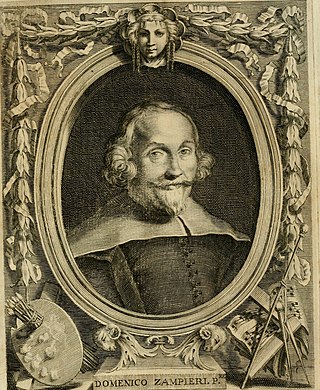
Domenico Zampieri, known by the diminutive Domenichino after his shortness, was an Italian Baroque painter of the Bolognese School of painters.

Jusepe de Ribera was a Spanish painter and printmaker. Ribera, Francisco de Zurbarán, Bartolomé Esteban Murillo, and the singular Diego Velázquez, are regarded as the major artists of Spanish Baroque painting. Referring to a series of Ribera exhibitions held in the late 20th century, Philippe de Montebello wrote "If Ribera's status as the undisputed protagonist of Neapolitan painting had ever been in doubt, it was no longer. Indeed, to many it seemed that Ribera emerged from these exhibitions as not simply the greatest Neapolitan artist of his age but one of the outstanding European masters of the seventeenth century." Jusepe de Ribera has also been referred to as José de Ribera, Josep de Ribera, and Lo Spagnoletto by his contemporaries, early historians, and biographers.

The Denial of Saint Peter(La Negazione di Pietro) is a painting finished around 1610 by the Italian painter Caravaggio. It depicts Peter denying Jesus after Jesus was arrested. The painting is housed in the Metropolitan Museum of Art in New York City.

Mattia Preti was an Italian Baroque artist who worked in Italy and Malta. He was appointed a Member of the Order of Saint John.

The Church and Convent of the Girolamini or Gerolamini is a church and ecclesiastical complex in Naples, Italy. It is located directly across from the Cathedral of Naples on via Duomo. The facade is across the homonymous piazza and street from Santa Maria della Colonna. It is one block west of Via Duomo.

Sant'Anna dei Lombardi,, and also known as Santa Maria di Monte Oliveto, is an ancient church and convent located in piazza Monteoliveto in central Naples, Italy. Across Monteoliveto street from the Fountain in the square is the Renaissance palace of Orsini di Gravina.

Giovanni Maria delle Piane was an aristocratic Genovese who served as primary court painter for over 60 years in the late-Baroque period. He is also known as "il Molinaretto".

Antonio Randa was an Italian painter of the classicist period, active in Ferrara, Modena, Rovigo, Florence, Comacchio and his native Bologna.
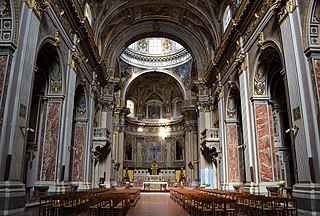
Santi Apostoli is a Baroque-style church in Naples, Italy.

San Giuseppe dei Ruffi or church of San Giuseppe dei Ruffo is a church located on piazzetta San Giuseppe dei Ruffi, in Naples, Italy.

The church of Santi Severino e Sossio and the annexed monastery are located on via Bartolommeo Capasso in Naples, Italy.
Carlo Miranda was an Italian mathematician, working on mathematical analysis, theory of elliptic partial differential equations and complex analysis: he is known for giving the first proof of the Poincaré–Miranda theorem, for Miranda's theorem in complex analysis, and for writing an influential monograph in the theory of elliptic partial differential equations.

Giovan (Gian) Domenico Vinaccia was an Italian architect, goldsmith, engineer and sculptor.
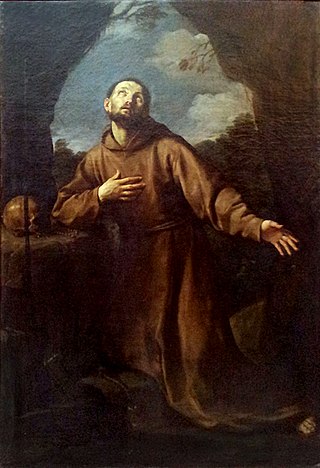
St. Francis in Ecstacy is a 1622 oil on canvas painting by Guido Reni, now in the Coppola Chapel in Girolamini church in Naples.
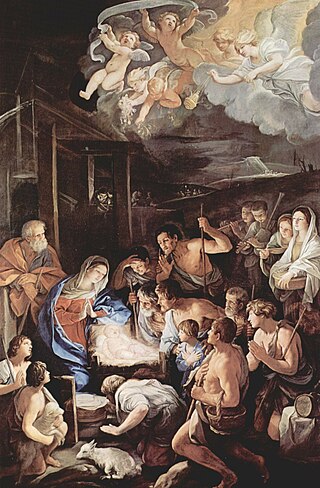
Adoration of the Shepherds is a c. 1642 oil on canvas painting by Guido Reni, commissioned by Giovan Battista Pisante, prior of the Certosa di San Martino in Naples, and still hanging on the main wall of the choir of that institution's church.

Jesus Meets John the Baptist is a c. 1622 oil on canvas painting by Guido Reni in the Girolamini, Naples, thought to have been one of three works given to that complex by Domenico Lercaro.

The Vico, and Vicoletto, dei Zuroli, also called Vicolo dei Zurli are two historic alleys in the city of Naples, they are located near via Forcella in the historic center of the city, they are located near via Forcella and near the church of Pio Monte della Misericordia, between Via dei Tribunali and Via Vicaria Vecchia, in the Pendino district.
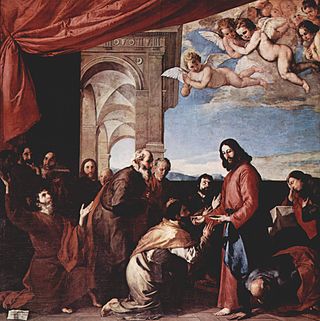
The Last Supper or The Communion of the Apostles is a 1651 oil on canvas painting by Jusepe de Ribera, still in the choir of the Certosa di San Martino in Naples, for which it was commissioned.

Baptism of Christ is a 1610-1615 oil on canvas painting by Battistello Caracciolo, now in the Girolamini, Naples.



















